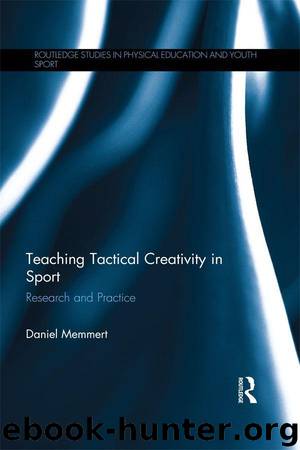Teaching Tactical Creativity in Sport: Research and Practice (Routledge Studies in Physical Education and Youth Sport) by Memmert Daniel

Author:Memmert, Daniel [Memmert, Daniel]
Language: eng
Format: azw3
ISBN: 9781317754060
Publisher: Taylor and Francis
Published: 2015-04-09T16:00:00+00:00
As described above, tactical creativity is always associated with the ability to generate new and unusual solutions. For this reason, the inattentional blindness paradigm is well suited for research on creative processes, since attention performance is associated with the discovery of unexpected objects. In further studies (Memmert, 2006c), it was shown that inattentional blindness is not a perceptual constant and that it can be modulated by experiences (see also Drew, Võ and Wolfe, 2013). Conversely, age effects could occur, which is important for the development of specific training programmes (Memmert, 2006c). A further group of 112 subjects watched the above-described “basketball video” by Simons and Chabris (1999). Here they had to count the passes by the white players (the primary task). The results indicated significant differences between experts in basketball and non-experts in basketball. Skilled players consciously perceived the unexpected object with a likelihood of about 60%. Independent of expertise, age effects existed between children (aged eight years) and juniors/adults, but not between players aged fourteen and twenty-two years. For children, the likelihood of noticing the gorilla decreases to less than 10%.
Another study by Memmert (2010b) establishes a direct link between inattentional blindness, expertise and creativity. In this experiment, 116 trained and untrained children and adolescents from different age groups performed four standardised tasks in a cross-sectional design. They completed a general and a sport-specific inattentional blindness task, the computer-controlled inattentional blindness task devised by Most et al. (2005), and the handball-specific inattentional blindness test by Memmert and Furley (2007). In addition, they were provided with a general and a sport-specific creativity test. These tests were a subtest of the creativity test for pre-school and school children (KVS-P, Krampen, 1996) as a facet of divergent thinking, and a handball-specific creativity test based on Johnson and Raab (2003). The results show that the trained adolescents with the ability to notice the free player could also describe more original solutions in the handball-specific situation than the thirtten-year-olds, who were “blind” to the free team mate (see Figure 5.7 right). At this point, it should be mentioned that the effect reported for sports was also found across other domains. The untrained adolescents who achieved better performances in the general inattentional blindness task also fared better in the general creativity test in comparison to the participants who could not describe the unexpected object (see Figure 5.7 left; for more details, see Memmert, 2009a).
Figure 5.7 Tactical creativity scores (±SE) as a function of attention and expertise (data from Memmert, 2010b)
Download
This site does not store any files on its server. We only index and link to content provided by other sites. Please contact the content providers to delete copyright contents if any and email us, we'll remove relevant links or contents immediately.
The Art of Coaching Workbook by Elena Aguilar(48065)
Trainspotting by Irvine Welsh(20055)
Twilight of the Idols With the Antichrist and Ecce Homo by Friedrich Nietzsche(17706)
Fangirl by Rainbow Rowell(7834)
Periodization Training for Sports by Tudor Bompa(7328)
Change Your Questions, Change Your Life by Marilee Adams(6641)
This Is How You Lose Her by Junot Diaz(5773)
Grit by Angela Duckworth(4738)
Red Sparrow by Jason Matthews(4668)
Asking the Right Questions: A Guide to Critical Thinking by M. Neil Browne & Stuart M. Keeley(4576)
Paper Towns by Green John(4169)
Room 212 by Kate Stewart(4107)
Ken Follett - World without end by Ken Follett(3973)
The Sports Rules Book by Human Kinetics(3588)
Housekeeping by Marilynne Robinson(3401)
The Motorcycle Diaries by Ernesto Che Guevara(3332)
Introduction to Kinesiology by Shirl J. Hoffman(3301)
Exercise Technique Manual for Resistance Training by National Strength & Conditioning Association(3292)
Double Down (Diary of a Wimpy Kid Book 11) by Jeff Kinney(3273)
